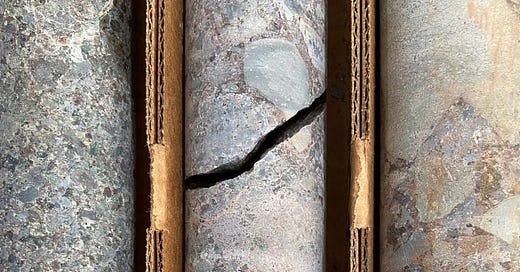Breccia all the way down: Bayhorse
Bayhorse Silver (BHS.V) put out a press release detailing two news items. The first were the assay results from the top section of its first “exploration” hole, the second were the IP results of a surface and downhole geophysics program.
I often talk to Bayhorse CEO Graeme O’Neill, as I do other CEO’s, pretty much about everything market related. We’re friends and I hold shares in the company. Those conversations are entirely off the record and Graeme is very careful to only discuss what has been publicly released. I thought it would be useful to do an on-the-record interview to “flesh out” the latest news release. We’re doing it in two parts, first the drill hole and assays, second the IP.
“This first hole had two purposes,” said O’Neill. “First, to test the VTEM anomaly at depth as part of what we have seen at Pegasus four thousand feet away in Idaho. We couldn’t, for a lot of reasons, drill at Pegasus last year and we thought this hole would indicate what to expect at Pegasus. Second, we wanted to get a sense of the depth and structure at the Bayhorse Mine.”
“As we expected, the first 40 meters of the hole was in unmineralized Andesite and then we drilled 40 meters of rhyolite,” said O’Neill. “The mineralization at the Bayhorse mine is found in pods and veins at the contact of the andesite and rhyolite. When the hole went from andesite to rhyolite it was a “clean” transition. Dr. Conway is of the opinion this indicates the rhyolite is a thrust fault intrusion into the andesite. Of particular note is the elevated silver values in the rhyolite. Up to 10 g/t, which is quite unusual”
“So the top of the hole confirmed that the rhyolite at the Mine extends vertically at least 400 feet and extends the depth of known mineralization at the Bayhorse mine to at least the end of the hole, or over 1,000 ft.” said O’Neill. “Historic drilling suggested this but we do not have core or assays on the 1984 drilling. We’ve found very high grade silver veins in the Bayhorse mine, with grades up to 15% silver, and copper grades to 17% and pods were mined that graded up to 240 oz silver a ton, all disclosed in our news releases, and this new drilling lends even more credence to our 43-101 inferred resource.”
At 88 meters the drill hit beccia. Which was unexpected. “The geos were excited,” said O’Neill. “We have always thought the Bayhorse deposit was epithermal in nature and the breccia is strong evidence for that.”
“Breccia” means broken rock. What broke it?
“Breccia are caused by a very hot body at depth,” said O’Neill. “Extremely hot fluids and gases at very high pressure push upwards through cracks and fissures in the rock and break up the rock they encounter. These fluids are often mineralized and while there are many causes, generally speaking, as pressure and temperature drops, it results in different minerals dropping out at different depths.”
“When we hit the breccia we took out our excellent XRF machine and ran it over every bit of the brecciated core. The XRF showed elevated levels of copper in every bit of that core,” said O’Neill. “Our geos were looking for evidence of a copper porphyry at depth and we are pretty sure this is a proxy for what we’ll find at Pegasus.”
“We submitted 115 meters for assay and were pleasantly surprised that the assays confirmed continuous copper mineralization in that core,” said O’Neill.
After the Christmas break drilling continued. “We had a planned depth of 875 feet but we have actually drilled to 1023,” said O’Neill. “Our exploration geologist on the spot, Mark Abrams, suggested that there was a lot of interesting stuff in the breccia and that we should go deeper. We ended the hole still in breccia with some rhyolite, that was unexpected”
O’Neill emphasized the idea that the underground hole at the Bayhorse mine was almost certainly a proxy for what Bayhorse expects to find on the other side of the Snake River at the undrilled Pegasus project. Which makes sense given that the VTEM on the Oregon side is strikingly similar to the anomalies in Idaho 4000-5000 feet away. “5000 feet is nothing geologically,” said O’Neill, “just spitting distance”.
There is a very good chance that the Bayhorse mine is the western end of a very large, mineralized, structure that the VTEM shows extends from over a mile north of the Bayhorse, under the reservoir, for at least another mile past the Bayhorse to the southeast to the end of the Idaho portion of the VTEM signature. The offset presence of the Bayhorse rhyolite at the Pegasus project suggests this may be the case as do the Idaho side VTEM “blobs”.
The rest of the brecciated core has been delivered to the lab for assay and, at the very bottom of the hole, visible bits of chalcopyrite, that typically contains high grade copper, were found. Quite properly, O’Neill is not commenting on the last few hundred meters of core until the assays are returned. However, the fact that, looking at the core, an explorationist of Mark Abram’s experience advised drilling deeper is telling.
I will be interviewing Graeme again this week on the other information in the press release, the downhole IP results. In the release there is a wonderful 3D graphic of the low resistivity and high chargeability zones the IP revealed. While the core was filled with smoke, the IP may well have indicated where the fire is.
(Disclaimer: Graeme O’Neill is a friend. I own shares in Bayhorse Silver and I may buy or sell at any time. This is not investment advice. Do your own due diligence. Call the CEO.)



